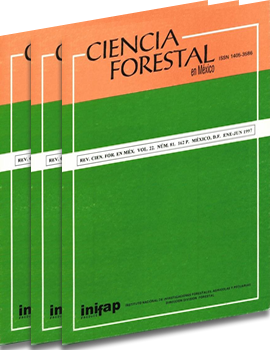COMPORTAMIENTO DE GENOTIPOS DE MAÍZ EN CULTIVOS EN CALLEJONES CON Erythrina poeppigiana, Calliandra calothyrsus y Gliricidia sepium·
Keywords:
Genotypes, maize, alley cropping, analysis of growth, position, forest speciesAbstract
The experiment was conducted in the "La Montaña" experimental fann at the Tropical Agricultural Center for Research and Training (CATIE) in Turrialba, C.R. from June to December 1992, to evaluate the influence of three species on the vegetative and reproductive behavior of four genotypes of maize, considering row position in alley croping. Maize. were established, in alleys of Erythrina poeppigiana (Walpers) O. F. COOK, Calliandra ca/othyrsus Meissn y Gliricidia sepium (Jacquin) Steud; a monoculture treatment was included. The maize genotypes used were: Tuxpeño, H3, H5 and Centapasaquina.
The random block with divided plots design was used. The main plot was dedicated to trec species and monoculture; a subplot corresponded to maize genotypes, with three repetitions and 16 treatments. Four evaluations were carried out in maize, in randomly chosen subplots within the experimental units, formed by six rows. Measurements of tree species were made in each crop evaluation. Trees were pruned at six months. Growth, yield and morphological, physiological, and harvest index variables were evaluated. Results included and analysis by tree species, the monoculture, genotypes and location of the maize row in the alley, at exception off yield per hectare. Tree growth and biomass production is also presented.
At 65 days a:fter planting, the greatest effect of tree species growth, and biomass production in maize was. observed, the highest averages in the maize growth, biomass production and foliar area index was obtained in the association with C. calothyrsus. The genotypes evaluated showed the highest growth. foliar area index and relative growth at 65 days after seeding. The greatest grain yield was obtained in the monoculture.
The H3 was best genotype with a highest growth in foliar area, plant height, stem diameter, foliar area index and dry material and grain production.
When the distance between plants was increased with respect to trees, greater photosinthetic efficiency was obtained and thus greater straw and grain production C. calothyrsus and E. poeppigiana, showed the greatest growth in height, number of regrowths and canopy diameter in maize and trees. The highest averages in dry material production were shown with C calothyrsus.
Downloads
Downloads
Published
How to Cite
Issue
Section
License
The authors who publish in Revista Mexicana de Ciencias Forestales accept the following conditions:
In accordance with copyright laws, Revista Mexicana de Ciencias Forestales recognizes and respects the authors’ moral right and ownership of property rights which will be transferred to the journal for dissemination in open access.
All the texts published by Revista Mexicana de Ciencias Forestales –with no exception– are distributed under a Creative Commons License Attribution-NonCommercial 4.0 International (CC BY-NC 4.0), which allows third parties to use the publication as long as the work’s authorship and its first publication in this journal are mentioned
The author(s) can enter into independent and additional contractual agreements for the nonexclusive distribution of the version of the article published in Revista Mexicana de Ciencias Forestales (for example, include it into an institutional repository or publish it in a book) as long as it is clearly and explicitly indicated that the work was published for the first time in Revista Mexicana de Ciencias Forestales.
For all the above, the authors shall send the form of Letter-transfer of Property Rights for the first publication duly filled in and signed by the author(s). This form must be sent as a PDF file to: ciencia.forestal2@inifap.gob.mx
This work is licensed under a Creative Commons Attribution-Noncommercial 4.0 International license.


